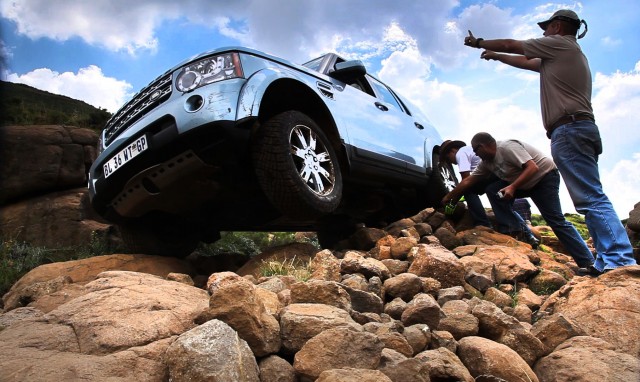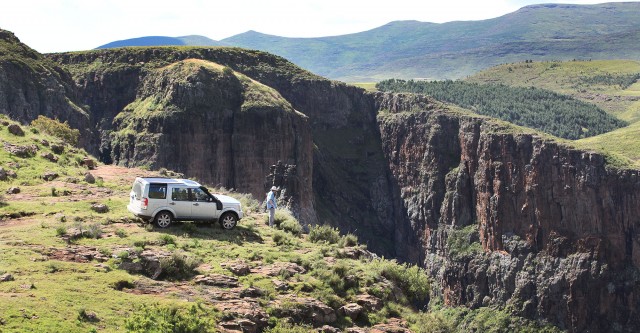Some years ago I fell out of favor with Land Rover South Africa when I reviewed their newly released Discovery-2. I didn’t like it one bit. And that was because LR had replaced a centre differential lock with a traction control system that did not work well. So from what was a great off-roader, they had updated it with a bad one. The many other improvements in the Discovery-2 did not make up for the now lack of good off-road performance. I made the mistake of saying so in the South African press, a community of writers mostly stifled by advertisers pressurizing publishers.
Then in 2012 they approached me with the idea of giving me a Land Rover Discovery-4 (LR-4) as a long-term sponsorship.
“If we gave you one for a year, what would you do with it? This was the question asked by LR’s chief marketing man, Roland Reid.
“I would take it on Southern Africa’s most challenging public road and shoot a TV show. Baboons Pass in Lesotho.”
The other members of the marketing team in the room, most of who were around way back in the days of the Disco-2, mumbled and shook their heads in disapproval. But Roland, it seemed, had more confidence in his product than they.
“Okay. Andrew. I’m up for it,” he said.
“That is fantastic. I know Baboons Pass is extreme. If the LR4 copes, it will be quite a feat. Either way, I do not believe it will accomplish this without some damage. Are you okay with that?” I asked.
“No problem. It’s a deal.” I loved his unbridled enthusiasm.
“And what if I fail?” I asked, almost regretting the question.
“Then I will send my own people from the LR Experience to prove to you that it can be done.”
“Can I film that too?”
“Oh, yes” he replied.
“Then we have a deal.”
It was a major breakthrough for my relationship with Land Rover. I just hoped that the vehicle would live up to the task. The truth is, I really didn’t know if it would. Neither had I driven the LR4 off road before, and neither had I driven Baboons Pass. Perhaps I had bitten off more than I could chew?
View the videos
I suggest now that you view the video before continuing this article. It is in two parts. Overland enthusiasts may have many questions about our drive and some of the choices we made. Some answers to these follow below.
The pass
Baboons is recognized as probably the roughest and most challenging public road in Southern Africa. It is indicated on more than one map as a vehicular track, but it’s more of a donkey trail than a road. Providing its distance is irrelevant as the going is so slow, it is better measured in time. A large section of the trail had been upgraded and we found evidence of a mechanical digger. This, I was told, saved us well over and hour. The improved section could be regarded as a grade-three trail where one averages about five kilometers per hour. When the grade four and five sections happen, they happen with a bang. Drivers are confronted with the inner thought, ‘How the hell am I going to get over that?’ But over you go, one rock climb, switchback, at a time, inch by inch. Speed often drops to half a kilometer per hour.
The tire conundrum
I was supported by two Defenders, a 110 and a 130. As it happened, at no time did any have to pull me, although the lead vehicle’s winch was used to remove a huge bolder that had fallen in our path. Significantly, both Defenders were equipped with 33-inch tyres deflated to about half-a-bar. By contrast, mine were 19” rims with low profile all-terrains pumped at three-bar. To prove my point, I needed to run standard, approved wheels and tyres, and pumped them this hard to protect them. For grip, the Defenders relied on front and rear diff-locks, while I relied on the Discovery-4’s traction control. My biggest concerns before the trip were that the Disco’s clearance would not be enough, and that while its traction-control is good, it would have to be truly brilliant to keep traction, considering the huge disadvantage I had with my tyres, especially if it rained. And it rained!
Driving
The other frustration was the over excitement of my helpers. I would, quite often, get conflicting opinions from those directing me over the rock obstacles. Sometimes I had two people simultaneously shouting directions and at others, differing advice about how I should drive. Shouts of “Go for it!,” or “Give it stick!’ frustrated me a bit. From inside the cab, more often than not my reaction was that because mechanical damage would mean failure, traversing any obstacle at speed was just not an option. As a result, I might have scraped off some of the Disco’s newness, but the undersides and machinery remained unharmed.
New revelations
Before this trip, if I had been asked, what do you prefer, traction-control or diff locks, I would answer without hesitation; diff locks. That’s because for me, until now, no traction control has been able to match the grip of lockers. But not all traction-controls work this well. Perhaps I can illustrate this with an anecdote. One of the final obstacles on Baboons Pass was a turn over a smooth, wet rock, at an angle of probably 30°. From the driver’s seat, I had to get my front wheels into the rock before applying power. Too much speed to early and the wheels would hit the base of the rock with such a knock and bounce, that traction and momentum would be instantly lost. Now, as the front wheels lifted, I applied firm accelerator, But almost nothing happened. That V6 diesel is no slouch, but at this time it barely ticked over. I pushed my right foot as far as it would go, but still nothing… the Discovery creeping ever so slowly up and over. Video footage from the outside later revealed what was happening. The wheels were spinning, ever so slowly. The traction control limited the power seemingly knowing that any more power would result in slip, and probably a slide backwards. I mounted the obstacle with consummate ease, and my crew all clapped, thinking, completely wrongly, that my superior driving skills had done such a good job. This Discovery made me look very good – not something that is very easy to do.
I also learnt some tricks of the Discovery that they didn’t tell me about at the Land Rover Experience training. (Perhaps I should have done the advanced course) Its suspension can lift to provide extraordinary clearance, if you know how to ‘trick it’. I needn’t have worried.
Conclusion
The Discovery-4 is technically brilliant – for more reasons than I ever gave it credit for. On the open road and in town, it is competent, comfortable a very easy to live with. That’s where 99% of it will be appreciated. But it can, if asked, tackle very difficult off-road terrain – and this is significant – even by inexperienced drivers. With minimal training, it can make a novice look like a seasoned expert.
But don’t let this make you think the Disco breezed over the pass. It was a real challenge for the vehicle and me. But the lasting impression is that this is an astonishing piece of kit, and the minds that thought it up, must have been a very clever bunch. In addition, I have now concluded once and for all, that solid axles are not necessary for really outstanding off-road ability.
The other conclusion that while the mechanicals are a marvel, and it has the ability to traverse really challenging off-road conditions, its build strength is not such that it will last a very long time in such conditions. As almost every part of the LR4 is controlled electronically, the failure of a single sensor or of one its delicate air springs, will bring this vehicle to a stop. So as an overlander, I regard it as a high-maintenance machine that must carry with it, a computer enabled to override its electronics when far from a dealer.
So I wouldn’t recommend that anyone buy a LR4 if their prime objective was to find the most difficult terrain and drive it. The Defenders, once having done Baboons ten times, will probably suffer no more than some worn bushes, but the Discovery, not being built to tackle this kind of terrain day after day, would no doubt feel the pains of battle rather sooner.
More of Andrew’s videos are available on 4xoverland.com






